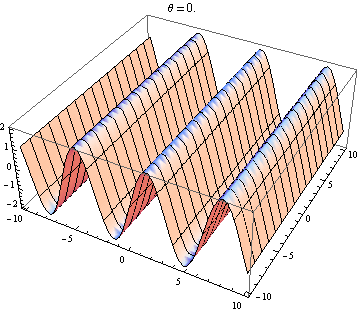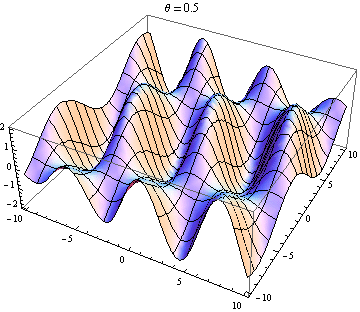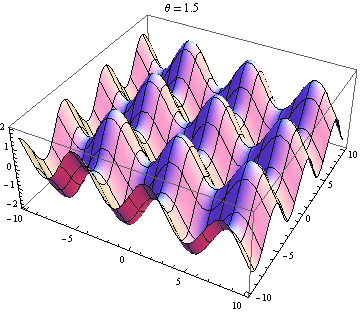Here's how I would suggest thinking about it. This is a sinusoidal wave:

Is that described by cosine formula or a sine formula? Well, as it stands, neither. It's just a thing that exists in space, there are no numbers attached.
In order to represent this wave by a formula, you need to find a way to represent points in space and time by numbers. That's what a coordinate system is for. And in order to apply a coordinate system, you need to choose some spacetime point to be labeled $(t, x) = (0, 0)$. For example, you might choose that point like this:

Now that every point is labeled by a number, you can meaningfully talk about what formula describes the wave. To do so, take a look at one specific "slice" of time, and at one specific point, for example the time and location that we chose to be $(t, x) = (0, 0)$.

You'll notice that at $(0,0)$, the wave has an value of zero, and its derivative is at a maximum. That uniquely matches the formula $y = \sin(kx - \omega t)$.
But what if you take the same wave and put a different coordinate system on it - that is, choose a different location to be position zero? You might get something like this:

It's the same wave, we've just chosen different labels for the points in the space the wave is traveling through. Suppose we call these new labels $(t',x')$. So let's look at the snapshot at $t'=0$ (when I write something with a prime like this, it means "$t$ in the primed coordinate system") with this new coordinate system.

Now, at the point we've chosen to call $(0,0)$, the wave is at its maximum. So with this new coordinate system, it doesn't match $y = \sin(kx' - \omega t')$; instead, the formula that matches the wave is $y = \cos(kx' - \omega t')$.
Of course, there are an infinite number of other ways you could choose the coordinate system. For example, suppose you choose a double-primed coordinate system $(t'',x'')$ so that the same time is labeled zero, but instead choose the position coordinates such that the $t'' = 0$ snapshot looks like this:

With this labeling, the wave doesn't match either the sine formula or the cosine formula. So what can you do? Use a shifted coordinate. For example, you can see that the wave crosses zero with a positive derivative at some negative value around $-2$. (The value is actually $-8\pi/11$.) Since you already know how to write the formula for a wave which crosses zero with positive derivative at position zero, you can do that and just use $x'' + 8\pi/11$ as your position coordinate. You can think of this as shifting the coordinate system back so that the zero point falls where the wave crosses zero.

So the formula would be
$$y = \sin\biggl[k\biggl(x'' + \frac{8\pi}{11}\biggr) - \omega t\biggr]$$
Alternatively, since you already know how to write the formula for a wave which hits its maximum at position zero, you could do that instead: shift the coordinate system back only enough so that the zero point falls where the wave hits its maximum.

You would need to shift by $5\pi/22$, which is equivalent to using $x'' + 5\pi/22$ as your position coordinate. So in this case the formula would be
$$y = \cos\biggl[k\biggl(x'' + \frac{5\pi}{22}\biggr) - \omega t\biggr]$$
You may notice that all these different equations for the wave take the general form
$$y = \sin(kx - \omega t + \phi_s)$$
or
$$y = \cos(kx - \omega t + \phi_c)$$
You can use either of these; they both describe the same kind of wave, as long as you pick the value of $\phi$ correctly for your coordinate system. For example, in the latest of the three cases I presented (the double-primed coordinates), you could choose $\phi_s'' = 8\pi/11$ and use the sine formula, or you could choose $\phi_c'' = 5\pi/22$ and use the cosine formula. It's the same thing either way (and you can show this mathematically, too). In the second case, the single-primed coordinates, the cosine formula worked with $\phi_c' = 0$, but you could just as well have used the sine formula with $\phi_s' = \pi/2$. And in the first case, the sine formula worked with $\phi_s = 0$, but you could also have used the cosine formula with $\phi_c = -\pi/2$.
In most resources you will see at your level, the author will choose to use one or the other of these formulas consistently, i.e. always cosine, or always sine. In fact, they might always choose the coordinate system that makes $\phi$ be zero. But it's useful to remember that, in case you ever have to use a different coordinate system (which you usually will, in higher-level physics), you can always use either of the general formulas, the sine or the cosine, and just pick the value of $\phi$ that makes things work out.
The other answer are good, but this might help you visualise the result. It is easy to produce visualizations if you have access to a package like Mathematica (you could also do this with python+matplotlib, gnuplot or Matlab or just about anything really). I've generated plots of two waves in 2D, one going in the positive $x$ direction and the other going at an angle $\theta$ relative to the $x$ axis. The amplitudes, wavelengths and frequencies are the same. Here is the code:
wave1[x_, y_, t_] := Sin[x - t];
wave2[x_, y_, t_, \[Theta]_] := Sin[Cos[\[Theta]] x + Sin[\[Theta]] y - t];
frames[\[Theta]_] := frames[\[Theta]] = Table[Plot3D[wave1[x, y, t] + wave2[x, y, t, \[Theta]],
{x, -10, 10}, {y, -10, 10}, PlotLabel -> "\[Theta] = " <> ToString[\[Theta]]], {t, 0, 10}];
Table[Export["twowaves_\[Theta]_" <> ToString[\[Theta]] <> ".gif", frames[\[Theta]]], {\[Theta], 0, 2 \[Pi], 0.5}]
Selected plots shown below. Note that the sum of waves simplifies to
$$ \sin(x-t)+\sin(\cos(\theta)x+\sin(\theta)y-t)=2 \cos\left(\frac{1}{2} x \left(\cos\theta-1\right)+\frac{1}{2} y \sin\theta\right) \sin\left(\frac{1}{2} x \left(\cos\theta+1\right)+\frac{1}{2} y \sin\theta-t\right). $$
You only get a standing wave if the space and time dependence seperates. So you need the $x$ and $y$ terms in the $\sin$ to vanish. This requires $\cos\theta=-1$ and $\sin\theta=0$, which has the unique (up to $2\pi$) solution $\theta=\pi$. So you only get standing waves if the two waves are counter propagating. Every other case gives you a travelling wave (the $\sin$ term) modulated by a space-dependent amplitude (the $\cos$ term).
Both waves in the positive $x$ direction:

Wave 2 going slightly up and to the right:

Wave 2 going nearly 90 degrees to wave 1:

Wave 2 nearly opposite wave 1:













Best Answer
If a wave is $f(x,t)=Re[e^{ikx-i\omega t}]$ with $\omega>0$, then it goes right if $k>0$ or left if $k<0$. Do you see why? Try picking two or three values of $t$ and making plots...
But,you can alternately write a wave as $f(x,t)=Re[e^{ikx+i\omega t}]$, and now it's reverse! $k>0$ is left-traveling. (In practice, it would be more common to write $f(x,t)=Re[e^{-ikx+i\omega t}]$ so that $k$ has the normal sign convention.)
So anyway, the key issue is whether the wave's time dependence is $e^{-i\omega t}$ or $e^{+i\omega t}$. It can be a tricky issue because sometimes this time-dependent factor is omitted to make the formulas look simpler. In general, one needs to look through the book or paper to see if the time-dependent factor is written down somewhere.
If they don't say it explicitly, the rule-of-thumb is: Electrical engineers almost always use $e^{+i\omega t}$ and physicists almost always use $e^{-i\omega t}$.
Luckily for you, there's one area that is completely unambiguous: The Schrodinger equation universally uses $e^{-i\omega t}$ (where $\omega=E/\hbar$). So you can count on that everywhere in quantum mechanics. That case is applicable to you.
(One could imagine an evil twin of the Schrodinger equation with the opposite sign on $i$, i.e. $-i\hbar \partial \Psi/\partial t = H\Psi$. It's objectively no less correct than the traditional Schrodinger equation, but uses $e^{+i\omega t}$ time dependence instead. Lucky for us, nobody has ever used this version, as far as I know!)